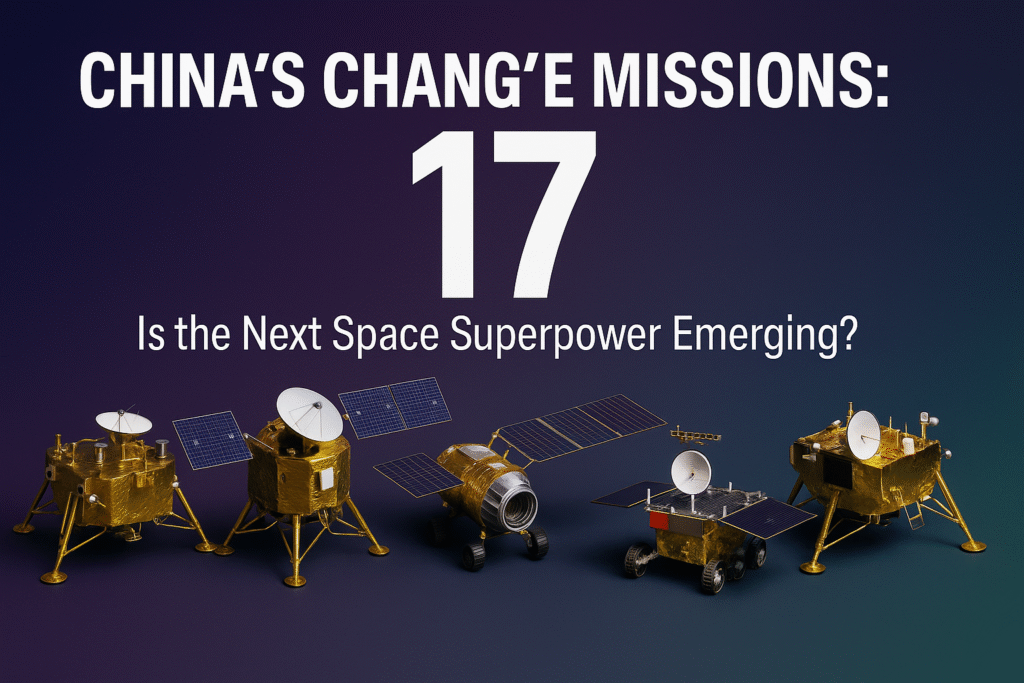
As the world turns its attention back to the Moon, China is quickly becoming a major player in space, even catching some experts by surprise. Through its Chang’e lunar China moon missions, China is not only gathering moon rocks but also quietly creating a plan for a lasting presence on the Moon.
Is the world seeing the rise of a new space superpower?
The answer can be found in the dust from China’s moon missions.
What Are the Chang’e Missions?
Named after the Chinese moon goddess Chang’e, these are a series of robotic lunar missions that started in 2007.
Over time, they have landed on the Moon, gathered samples, and even explored the far side—an achievement no other country has done.
| Mission | Year | Objective | Status |
|---|---|---|---|
| Chang’e 1 | 2007 | Orbital mapping | Successful |
| Chang’e 2 | 2010 | High-resolution imaging | Successful |
| Chang’e 3 | 2013 | Lander + Yutu rover (Moon’s near side) | Successful |
| Chang’e 4 | 2019 | First soft landing on Moon’s far side | Historic |
| Chang’e 5 | 2020 | Sample return mission | Completed |
| Chang’e 6 | 2024 | Sample return from far side | Completed |
| Chang’e 7/8 | 2026+ | Lunar South Pole exploration, base testing | First soft landing on the moon’s far side |
Why the Moon? Why Now?
The Moon is no longer just about showing off—it’s also about valuable resources:
- Helium-3: A rare fuel for future nuclear reactors
- Water Ice: Can be used to make oxygen and rocket fuel
- Metals: Like titanium and rare earth elements that are important for technology and defense
China is pushing to explore the Moon’s south pole to get access to these resources and build a long-term research station by 2030.
How China Is Gaining a Lead
1. Consistent Plan
China’s 10-year lunar program follows a clear path: first orbiting, then landing, then returning samples, and finally setting up a crewed base.
2. Advanced Robotics
China’s landers and rovers, like Yutu-2, use smart navigation, powered by artificial intelligence and communication systems similar to 5G.
3. Lunar Satellite System
They are building a satellite network around the Moon to help with real-time communication, which is needed for long-term bases.
4. International Partnerships
China is inviting countries like Russia, Venezuela, the UAE, and others to join its International Lunar Research Station (ILRS)—competing with NASA’s Artemis program.
China vs NASA—The Moon Race Heats Up
| Criteria | China | NASA |
|---|---|---|
| First to Moon Samples | 2020 (Chang’e 5) | 1972 (Apollo 17) |
| Far Side Landing | First-ever (Chang’e 4, 2019) | Not yet attempted |
| Moon Base Plan | ILRS by 2030 | Artemis Base Camp (delayed to 2030s) |
| Crew Landing Target | By 2030 | Artemis III in 2026–27 (delays possible) |
Global Reactions on China Moon Mission
While the US and allies focus on NASA’s Artemis missions, many developing nations are aligning with China’s more open invitation model. This reshapes the global space landscape, giving China diplomatic leverage far beyond Earth.
“China is methodically working toward moon dominance—without fanfare, but with stunning success.”
— Dr. Emily Richards, Lunar Geopolitics Analyst
The Future: From Robots to Human Footprints
The upcoming Chang’e 7 and Chang’e 8 missions will explore the moon’s south pole, try to extract resources, and maybe use 3D printing to build bases on the moon.
If these efforts work, the ILRS could be the first long-term research station on the moon, where scientists from different countries and robots can work together.
By 2030, China plans to send astronauts to the moon—possibly even before NASA does again.
Conclusion: The Dawn of a New Moon Era
The China Moon program, through its Chang’e missions, isn’t just about exploration—it’s about infrastructure, security, energy, and global leadership.
In the next 10 years, the Moon could become humanity’s next industrial zone, and China seems determined to plant its flag—not just in the dust, but in history.
Regards : SmartAffairs
What is the latest update on the China Moon program?
A: The most recent China Moon mission, Chang’e 6, successfully returned samples from the far side of the Moon in 2024—making China the first nation to achieve this milestone.
Why is the China Moon program focused on the lunar south pole?
The China Moon exploration strategy targets the Moon’s south pole due to its permanent shadows, which may contain frozen water, a key resource for future lunar bases and space travel.
Is China building a permanent moon base?
Yes, through the China Moon initiative, the country plans to build the International Lunar Research Station (ILRS) by 2030, which will serve as a robotic and crewed outpost on the Moon.
What are the long-term goals of the China Moon project?
The ultimate goal of the China Moon missions is to establish lunar sovereignty, extract resources like helium-3, and support deep-space exploration with a sustainable presence on the Moon.
